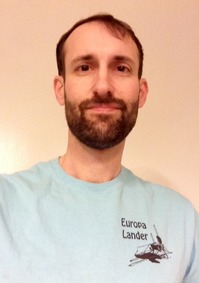ELSI Blog
90 My History with the Proposed Europa Clipper Mission
 I don't think much of astrology. What should a chance alignment or apparent motion seen from our arbitrary spot in the cosmos have to do with me? And what about the new discoveries happening every week? Why don't astrologers account for those? Why doesn't my horoscope have anything to say, for example, about methane on Mars, or the10-billion-year-old planet Kepler 10b?
I don't think much of astrology. What should a chance alignment or apparent motion seen from our arbitrary spot in the cosmos have to do with me? And what about the new discoveries happening every week? Why don't astrologers account for those? Why doesn't my horoscope have anything to say, for example, about methane on Mars, or the10-billion-year-old planet Kepler 10b?
I adore nature's beauty and its mystery. I see art in a sunset, and poetry in how the sky can frame a memorable moment. I enjoyed one such moment recently, while attending the Outer Planets Assessment Group (OPAG) meeting in Mountain View, California. After a full day's work hearing updates to and discussing implications of NASA's outer-planet science program, Bob Pappalardo informally organized a celebratory evening get-together at a local wine bar. Our small group of scientists gathered and made a toast (or kanpai, かんぱい, in Japan).
On an outdoor patio, with Jupiter above us, Bob, the lead scientist for the Europa Clipper mission study, reminded us of the many years spent developing mission concepts, and the many people who have contributed their ideas and their time to a voyage of discovery that's just beginning. Ron Greeley was a founder of planetary science, and during his final years was a leader in studies of Europa mission concepts. Torrence Johnson, who participated in Voyager and served as Project Scientist for Galileo, has also been a luminary for recent studies. As Bob finished his speech, a meteorite streaked northward overhead and disappeared in a flash of fire. The line across the sky, ornamented by a tiny dot next to its center--in reality, much larger than Earth--will be remain etched in my memory.
NASA has prioritized a mission to study Jupiter's moon Europa. This marks the beginning of a new phase of space exploration, in which we begin to fathom alien oceans. I'm happy to live in a time when I can take part in such an endeavor. Getting to this point has been a long journey by itself.
Since starting at JPL in late 2007, I have split my time between studying extraterrestrial oceans and helping to refine the science case for Europa. In 2011, our orbiter design to accompany an ESA Ganymede orbiter exceeded NASA budget constraints, so we went back to the drawing board. NASA asked us to scale back the orbiter concept by eliminating or shrinking scientific investigations. We also studied alternative approaches to understanding Europa's habitability, including skipping a comprehensive survey of the moon and landing on it directly. Ultimately, we found that landing safely at a site with well understood geology and composition calls for more reconnaissance of Europa's surface than the lander concept could do. At the same time, we were studying a multiple-flyby approach, inspired partly by the Juno mission, which could achieve most of the high profile science over a longer time period than the orbiter (2 yrs vs 30 days), without risking biological contamination of Europa by ending the mission (crashing) at its surface. This approach became the current Europa Clipper concept.
Efforts toward the current Europa concept begin before I entered graduate school in 2001. When I started my PhD project in Seattle with J. Michael Brown, investigating pressure's affect on Europa's ocean chemistry, I had little insight into how NASA missions start. I had no idea I might be involved in one. Toward the end of my studies, I had become an expert on Europa, and I had begun working with some of my current collaborators, including Jun Kimura, Hauke Hussmann, and Jason Goodman. It's difficult to encompass all of the things I've learned since coming to JPL. It's a pleasure to think about how we have all grown over the years. I remember visiting Tokyo after starting at JPL, with other colleagues from JPL who were interested in discussing a JAXA Jupiter Magnetospheric Orbiter to join the ESA and NASA missions. None of those designs came to be, but Jun has since gone on to be a key contributor to JAXA missions, including JAXA's part in the Ganymede Laser Altimeter (GALA) on the JUICE (JUpiter ICy moons Explorer) mission that resulted from the ESA Ganymede orbiter concept. Visiting with Jun and with Sho Sasaki, among others, I could not have imagined that I would become a regular visitor to ELSI and have the opportunity to continue our work together. I'm excited to see what else the stars have in store.











